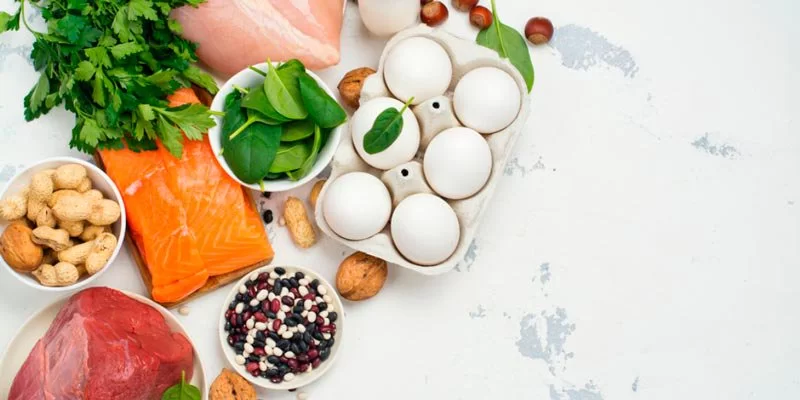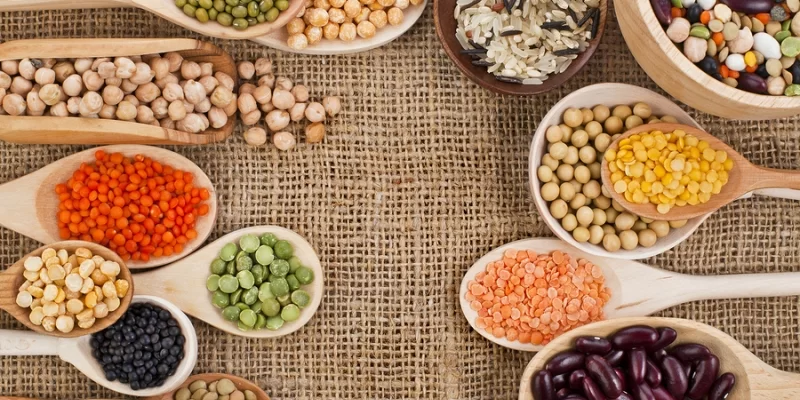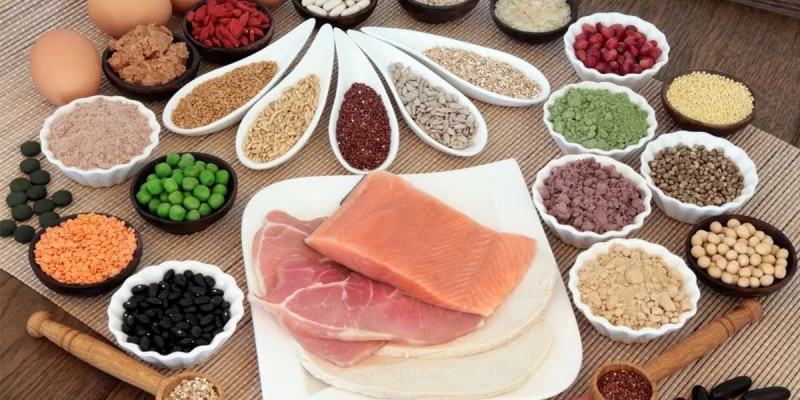Proteins are the most important nutrients in the human diet. You can get them from both animal products and plant foods. But nutritionists warn that their value varies. Our experts found out how animal and vegetable proteins differ, what are their main sources and which ones are more valuable for the body. We also learn why the health of vegetarians may be at risk.
Proteins: role in the human body, types

Proteins (proteins) are organic compounds that serve as the main building material for the cells and tissues of the body. They consist of amino acids (AMA) connected by a peptide bond, which make up muscles, tendons, ligaments, internal organs, and partly bones and cartilage.
Proteins perform a number of important functions in the body:
-
participate in the metabolism of fats, carbohydrates, minerals and vitamins;
-
form antibodies that protect against bacteria and viruses;
-
carry oxygen in the circulatory system;
-
transfer genetic information;
-
regulate the activity of the central nervous system and the brain;
-
ensure the normal condition of the skin, teeth, hair and nails;
-
serve as a source of energy (1 g of protein gives 4 kcal).
About 500 amino acids are known, but only 22 are involved in human life. 12 of them can be independently synthesized in the intestine from fat, carbohydrates and other amino acids, and 8 are essential. These include:
-
valine — necessary for muscle metabolism and proper functioning of the nervous system;
-
isoleucine — promotes the restoration of muscle tissue after heavy physical exertion, plays the role of a modulator of the immune system;
-
leucine — is involved in metabolic processes, the production of insulin, hemoglobin;
-
threonine — is part of collagen and elastin, is needed for the formation and maintenance of strong bone tissue, immunity;
-
methionine — neutralizes toxins, participates in the synthesis of enzymes, provides strong hair and nails;
-
lysine — necessary for the normal assimilation of proteins, the growth of muscle tissue, the synthesis of collagen and elastin;
-
phenylalanine — is involved in the production of many enzymes, helps the liver and kidneys to remove metabolic products;
-
tryptophan — necessary for the production of serotonin — the “hormone of happiness” and vitamin B3 (niacin), regulates mood, sleep.
These amino acids enter the body only with protein foods of animal or vegetable origin — they are not produced independently.
In addition to essential amino acids, there are 7 more conditionally essential amino acids:
-
arginine — regulates hormonal levels, the work of the cardiovascular system;
-
histidine — contributes to the supply of oxygen to organs, restores damaged tissues, strengthens the immune system;
-
glutamine — supports the immune system, affects muscle growth, prevents degenerative neurological diseases;
-
glycine — is involved in the functioning of the central nervous system, the digestive system, the production of collagen and elastin, protects against cancer;
-
proline — necessary for the formation of cartilage, healthy joints, muscles and skin;
-
tyrosine — affects the production of hormones, increases concentration, protects the body from the development of depression and its consequences;
-
cysteine — promotes muscle endurance, detoxifies the body, protects against radiation, the development of cancer.
These amino acids are synthesized in the intestines on their own, but only under the condition of a full supply of nutrients from food, the production of certain enzymes and hormones. During periods of illness or heavy physical exertion, their production may be insufficient to meet the metabolic needs of the body.
According to the content of amino acids, proteins are divided into:
-
to full-fledged, which include all irreplaceable AMC;
-
into defective, containing an insufficient amount of amino acids.
In addition, proteins differ from each other in the degree of assimilation — biological value. Some are absorbed by the body almost 100%, others — only 30%.
Knowing the nuances of the composition of amino acids and the digestibility of protein foods, you can learn more about the characteristics of animal and vegetable proteins, understand how they are similar and how they differ from each other.
Feature of animal proteins and their sources

Animal proteins contain a complete set of essential and conditionally essential amino acids, therefore they are considered complete.
Their main sources are meat, fish, seafood. They are also rich in dairy products, eggs.
The table shows the sources of animal protein and their quantitative content in food.
|
|
|
|
Chicken fillet
|
27–29
|
|
Turkey fillet
|
21–23
|
|
Meat beef, pork
|
19–22
|
|
Liver
|
18–20
|
|
by-products
|
15–17
|
|
Sausage, sausages
|
12–14
|
|
Fish caviar
|
28–31
|
|
Fish red
|
28–30
|
|
white fish
|
18–20
|
|
Shrimps
|
17–19
|
|
Cheese
|
24–26
|
|
Cottage cheese
|
15–17
|
|
Eggs
|
12–13
|
|
Dairy products
|
3–4
|
|
Milk
|
2–3
|
In addition, proteins from animal foods have a high biological value. For example, protein from a chicken egg is absorbed by the body by 97% (the highest rate of digestibility among all protein products), cottage cheese — by 93%. Protein is better absorbed from fermented milk products than from whole milk.
Regular consumption of a sufficient amount of food of animal origin is a guarantee that the body will receive the protein it needs (60–90 g per day) to perform its most important functions.
Feature of vegetable proteins and their sources

Vegetable proteins have a poorer amino acid composition, they may lack 2–3 essential amino acids (although the total amount of amino acids in them may be even higher than in meat). Their sources (the content in 100 g of the product is indicated):
-
soy — 33–35 g;
-
beans — 22–25 g;
-
lentils — 21–23 g;
-
mung (mung beans) — 23–25 g;
-
chickpeas (chickpeas) — 19–21 g;
-
nuts, seeds — 16–20 g;
-
bran — 19–21 g;
-
peas — 12–14 g;
-
pasta from durum wheat — 11–13 g;
-
buckwheat ‑11–13 g;
-
oatmeal — 10–12 g;
-
wheat and cereals based on it — spelled, bulgur — 10 g;
-
mushrooms — 3–4 g;
-
vegetables — 2–3 g.
Soy protein is as close as possible in composition to animal proteins (contains 7 essential amino acids — only methionine is missing). They are rich in soy milk, tofu cheese, soy sprouts, alfalfa. These products can be a good alternative to meat.
Lack of vegetable proteins — low biological value. They are absorbed by the body only 1/3. To get your daily protein intake and all the essential amino acids from plant foods, you need to consume legumes, nuts and cereals daily in large enough quantities.
Similarities and differences between animal and vegetable protein

Animal and vegetable protein contain amino acids necessary for the human body. Thanks to their regular intake with food, we get energy, absorb nutrients, build muscle mass, etc. In this they are similar.
But there are more differences between plant and animal proteins:
-
have a different amino acid composition — proteins from plant foods are poor in essential amino acids (may contain only 2–3 out of 8);
-
animal protein has a high biological value, almost 100% absorbed in the digestive tract.
Protein products of plant origin, unlike animal products, do not provide the necessary balance of amino acids in the body: the absence of one may interfere with the absorption of others.
That is why vegetarians risk their health — an inadequate diet, in which there is no meat, can lead to serious problems with the nervous, endocrine, cardiovascular systems of the body. To prevent this, it is necessary to ensure sufficient daily intake of different groups of plant protein products.
Weakness, drowsiness, forgetfulness, frequent headaches and colds can be the first signs of protein deficiency.
The benefits and harms of each type of protein
Despite the clear superiority of animal proteins over vegetable proteins, it cannot be said that they are unequivocally more useful. Yes, we get the amino acids we need from eggs, meat and dairy products, but it is necessary to take into account their overall nutritional value, vitamin and mineral composition.
EThere are several nuances that are important to take into account.
-
Protein foods of animal origin contain saturated fatty acids, which are transformed in the digestive tract into “bad” cholesterol. Excessive consumption of animal fats causes atherosclerosis (cholesterol deposition on the vascular walls) and leads to strokes and heart attacks.
-
According to a study by American scientists, people who often eat red meat are more likely to suffer from cardiovascular and oncological diseases.
-
Protein plant foods are rich in dietary fiber, which is necessary for the normal functioning of the intestines (they are not found in food of animal origin). They also contain many vitamins and antioxidants, macro- and microelements, without which the body cannot function normally.
-
Legumes contain special compounds — enzyme inhibitors. They contribute to the rapid removal of toxic substances from the body, prevent the development of inflammatory reactions and the occurrence of cancerous tumors.
-
Unlike beans and cereals, only meat contains methionine and vitamin B12, which is important for the normal functioning of the nervous system.
-
Animal foods contain heme iron, which is much better absorbed by the body than non-heme iron from plant protein foods.
-
Egg protein is a highly digestible source of essential amino acids, but often causes allergic reactions.
-
Soy products could be ideal meat substitutes. But they contain phytoestrogens — analogues of female sex hormones. Their frequent use can cause breast cancer in women with a genetic predisposition; in men, the risk of female-type fat deposits and the development of gynecomastia increases.
-
The most useful foods for getting a complete protein are fish, seafood, chicken and turkey fillets. They practically do not contain saturated fats (the composition of sea fish contains useful unsaturated omega fatty acids), there are vitamins of groups B, A, D, zinc, iron, selenium, potassium.
Conclusion
If we compare animal and vegetable proteins, the advantage of the former is obvious: they contain amino acids that are not synthesized by the body and are better absorbed. But if we look at protein foods in terms of nutritional composition and overall health benefits, the situation is ambiguous. In products containing vegetable protein, there are no harmful saturated fats, but there is fiber, antioxidants. But they are poor in vitamin B12 and iron.
Thus, our experts concluded: in the daily diet of a person who cares about his health, there must be products of both animal and vegetable origin. It is recommended to distribute them during the day as follows:
-
for breakfast — cheese, eggs, cottage cheese, cereals;
-
for lunch — meat, legumes, pasta;
-
for dinner — fish, dairy products.
A varied diet will ensure the supply of all the necessary amino acids, reduce the risk of problems with the immune system, skin, nails, and internal organs. Proper use of vegetable and animal proteins is the key to excellent health.


Добавить комментарий
Для отправки комментария вам необходимо авторизоваться.